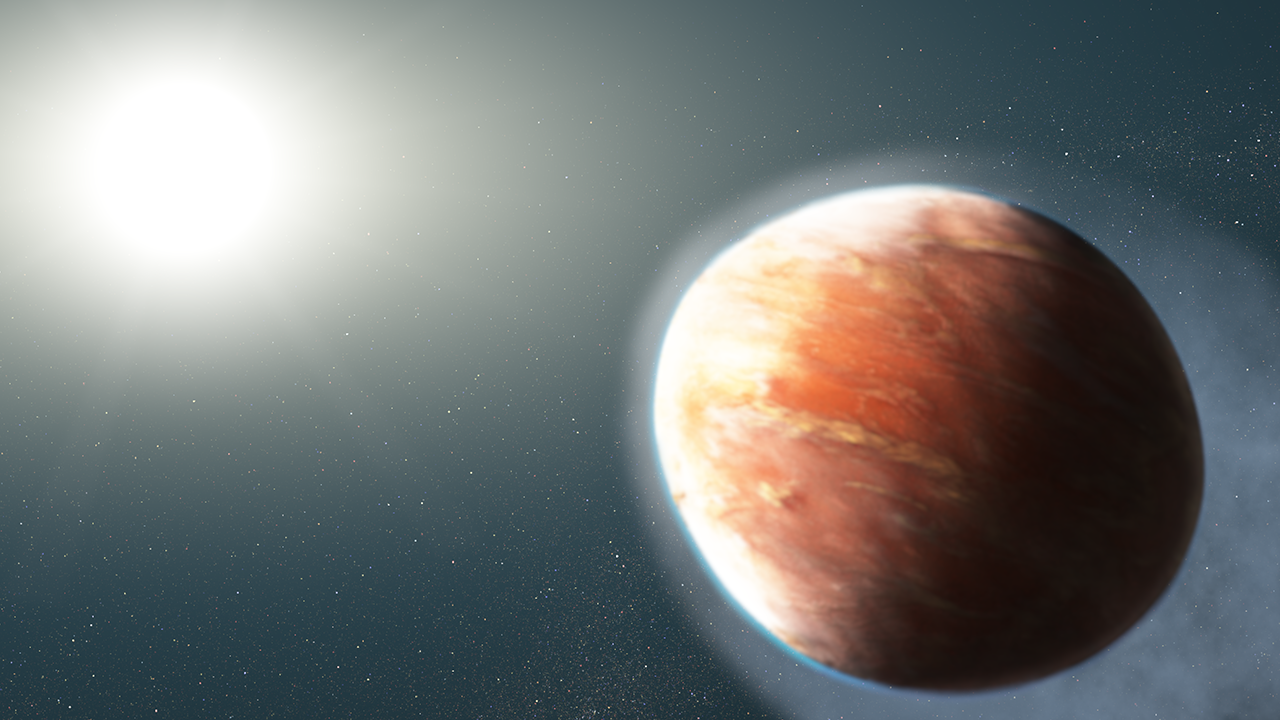It's Good! Hubble Telescope Scores Big with Football-Shaped Alien Planet
WASP-121b is burning up at 4,600 degrees.

Scientists scored a touchdown when they observed heavy metals escaping from the surface of a football-shaped exoplanet that's way too hot to handle.
The large and gassy "hot Jupiter," called WASP-121b, orbits so close to its sun that its temperature is 10 times greater than that of any other known planet. Its odd, football-like shape is also due to the planet's close proximity to the host star as it is on the verge of being ripped apart by the star's gravity.
Using the Hubble Space Telescope, the group of scientists observed heavy metals, such as iron and magnesium, escaping through the surface of the exoplanet — marking the first time heavy metals were observed floating away from an exoplanet's upper atmosphere.
Related: The Strangest Alien Planets (Gallery)
"Heavy metals have been seen in other hot Jupiters before, but only in the lower atmosphere so you don't know if they are escaping or not," David Sing a professor at the Earth and Planetary Science department at Johns Hopkins University in Maryland and lead author of the study, said in a statement by NASA. "With WASP-121b, we see magnesium and iron gas so far away from the planet that they're not gravitationally bound."
The temperature of the exoplanet's upper atmosphere reaches 4,600 degrees Fahrenheit (2,538 Celsius), according to the statement. Therefore, unlike other hot Jupiters that are still cool enough to condense iron and magnesium into clouds, this sizzling hot world emits the gases from its surface. Additionally, the exoplanet is also described as "so big and puffy" that its gravity is relatively weak compared to other planets, making it easier for the gases to escape.
"This is a planet being actively stripped of its atmosphere," Sing added. "In the case of WASP-121b, the hydrogen and helium gas is outflowing, almost like a river, and is dragging these metals with them. It's a very efficient mechanism for mass loss."
Get the Space.com Newsletter
Breaking space news, the latest updates on rocket launches, skywatching events and more!
The escaping heavy metals could also contribute to the exoplanet's rising temperatures. "These metals will make the atmosphere more opaque in the ultraviolet, which could be contributing to the heating of the upper atmosphere," Sing said.
Scientists are hoping to further study the exoplanet using NASA's upcoming James Webb Space Telescope, scheduled to launch in March 2021, in order to search for water and carbon dioxide under ultraviolet light.
The study was published on August 1 in The Astronomical Journal.
- Magnetic Fields of 'Hot Jupiter' Exoplanets Are Much Stronger Than We Thought
- New Method May Help Scientists Study Exoplanets at the Edge of Chaos
- This Gassy 'Preteen' Exoplanet With 2 Suns Is Losing Its Atmosphere. But Why?
Follow Passant Rabie on Twitter @passantrabie. Follow us on Twitter @Spacedotcom and on Facebook.
Join our Space Forums to keep talking space on the latest missions, night sky and more! And if you have a news tip, correction or comment, let us know at: community@space.com.

Passant Rabie is an award-winning journalist from Cairo, Egypt. Rabie moved to New York to pursue a master's degree in science journalism at New York University. She developed a strong passion for all things space, and guiding readers through the mysteries of the local universe. Rabie covers ongoing missions to distant planets and beyond, and breaks down recent discoveries in the world of astrophysics and the latest in ongoing space news. Prior to moving to New York, she spent years writing for independent media outlets across the Middle East and aims to produce accurate coverage of science stories within a regional context.









